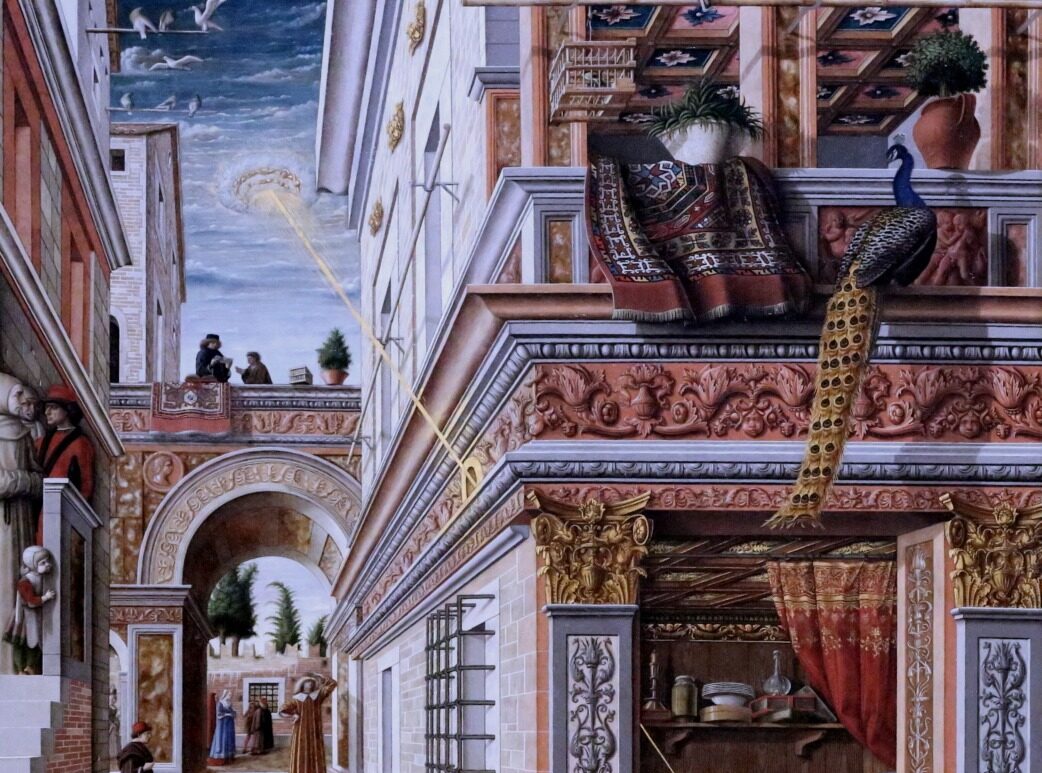‘Shadows on the Sky’: reviewing the works of Carlo Crivelli
The latest exhibition at the ‘Ikon gallery’ in Birmingham, titled Shadows on the Sky, displays the work of the Italian Renaissance artist, Carlo Crivelli. Shadows on the Sky is not only the first time Crivelli’s work has been brought to Birmingham but it is unique in being the first UK exhibition to be solely devoted to the work of the greatly unsung Renaissance artist.
Crivelli is certainly not a household name, even during his lifetime he was often overshadowed by the work of fellow Renaissance artists, like Leonardo da Vinci. His talents lay in experimental painting methods to explore how spatial dimensions affected the notion of reality. His paintings were religious and devotional objects, and many were hung as altarpieces and lit from below by candlelight.
Crivelli combines optical illusion, sculptural relief and the manipulation of perspective
The curators at ‘Ikon’ have managed to acquire pieces of work on loan, spanning the length of Crivelli’s career including altarpieces, panels and private devotional pieces. The finest works on display include a tempera on panel Virgin and Child, a tempera on wood Madonna and Child, with Saint Emidius an egg and oil on canvas. Crivelli’s work is preoccupied with revealing different levels of reality – both spiritual and material. Crivelli combines optical illusion, sculptural relief and the manipulation of perspective in order to create the perfect visual illusion. For example, Madonna and Child Crivelli offset illusionistic painting techniques with three-dimensional relief work. The Christ Child’s coral necklace is moulded from raised gesso, in an artful display of Crivelli using relief work to simultaneously undermine and enhance his illusionistic paintwork.
Crivelli appears most interested in using illusion. The title, Shadows on the Sky, alludes to detail from The Vision of the Blessed Gabriele, where a garland of fruit painted as a swag casts a shadow onto the background of a naturalistic sky. The shadow thus reveals the background for what it really is – a painted sky, not a window onto reality.
The work of Crivelli has come as a revelation to me
Similarly, a fly is painted on the left-hand side of the image of Saint Catherine of Alexandria. The fly is scaled to fit the reality of the viewer to remind the observer that the painting is an artifice as the fly acts as a representation of the real world by resting upon the object’s surface. However, some of the distorted perspectives in Crivelli’s work can be explained through context. The figure of Fra Gabriele Ferretti, the subject of The Vision of the Blessed Gabriele, has a head which appears to be too big for the scale of his body. This may be a deliberate distortion of scale as the work would have most likely been viewed from below and not from eye level.
The work of Crivelli has come as a revelation to me. The paintings feel as if they are incredible gems retrieved from an unimaginably distant age, and yet subsequently they possess an unmistakably modern quality. The combination of technical perfection and conceptual curiosity suggests an urgency to discover the truth beyond trickery, the reality beyond the illusion. Perhaps, Crivelli’s work speaks so poignantly to the digital age because the individual is forced to try and negotiate between different levels of reality daily; the individual struggles to exist in a world where the materiality of every day and the trickery of illusion are no longer cast into such sharp relief. Indeed, The Annunciation, with Saint Emidius almost looks as if it is a computer-generated image so perfect, smooth and sharp are Crivelli’s lines that any trace of brushwork seems non-existent.
Birmingham could not be further from the Renaissance Italy Crivelli was working in
There is something special about the exhibition being premiered in Birmingham at the ‘Ikon Gallery’. Birmingham could not be further from the Renaissance Italy Crivelli was working in, and yet the location seems to make the work all the more significant. After centuries of being in dimly lit spaces or on crowded walls in expansive galleries, it is refreshing to see Crivelli’s masterpieces shine in the most unlikely of locations. It is a privilege to view the paintings from the same perspective that Crivelli himself must have viewed all those centuries ago.
‘Ikon Gallery” is the perfect ‘small’ art gallery. The moderate size of the gallery spaces means that you are not overwhelmed by artwork, allowing you to really appreciate each piece on display. There is also another UK first exhibition taking place at ‘Ikon’ titled Under the Vast Sky. This exhibition is dedicated to the fascinating work of contemporary Swedish artist, Britta Marakatt-Labba, who uses embroidery to document and chronicle the history, culture and cosmology of the Sámi people, which I would also highly recommend visiting.
Overall, my visit to the ‘Ikon gallery’ was memorable and this small and thoughtfully curated exhibition exceeded all my expectations because it quietly had something profound to say.

Comments